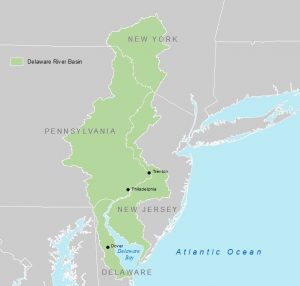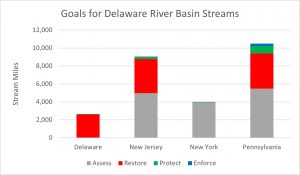 The William Penn Foundation provides extensive funding for protection and restoration activities in the four-state Delaware River Basin towards the long term goal of ensuring all 25,000+ miles of stream are fishable and swimmable. In 2020, the Center led a study for the Foundation to assess the feasibility of developing Basin-wide metrics to measure progress on securing sustained regulatory protections for streams. As part of this study, the Center reviewed state Clean Water Act policies and analyzed data provided by the Basin states. This analysis showed that only 6% of Delaware Basin streams are currently meeting both fishable and swimmable standards and quantified the opportunity to make progress on stream assessment, protection, and restoration, and enforcement of Clean Water Act standards (see results below). These results can be used by the Foundation to establish interim goals and track progress towards a fishable and swimmable Basin.
The William Penn Foundation provides extensive funding for protection and restoration activities in the four-state Delaware River Basin towards the long term goal of ensuring all 25,000+ miles of stream are fishable and swimmable. In 2020, the Center led a study for the Foundation to assess the feasibility of developing Basin-wide metrics to measure progress on securing sustained regulatory protections for streams. As part of this study, the Center reviewed state Clean Water Act policies and analyzed data provided by the Basin states. This analysis showed that only 6% of Delaware Basin streams are currently meeting both fishable and swimmable standards and quantified the opportunity to make progress on stream assessment, protection, and restoration, and enforcement of Clean Water Act standards (see results below). These results can be used by the Foundation to establish interim goals and track progress towards a fishable and swimmable Basin.
Nonprofits working in the Basin can use the study results to strategically target and better illustrate the impact of their work to ensure that water quality standards are met. This includes:
- conducting regular waterbody monitoring to document existing uses, gather water quality data to support reclassification petitions, and to supplement agency efforts to assess conditions
- petitioning for more stringent protection for specific waterbodies through a change in use designation
- submitting public comments on proposed revisions to water quality standards to secure more robust protections
- reviewing permit applications and submitting comments on proposed permits to help ensure that Clean Water Act protections are enforced

Results:
55% of stream miles in the Basin are unassessed for either aquatic life use or recreational use, making it difficult to determine their “fishable and swimmable” status. The goal for these streams is to conduct water quality monitoring to assess if they are meeting these designated uses.
4% of stream miles in the Basin are currently meeting fishable and swimmable standards but are not afforded any special protections. The goal is to increase protection for these streams through designation upgrades so that they can continue to support these uses.
39% of stream miles in the Basin have water quality conditions that do not fully support aquatic life use and/or recreational use. The goal for these streams is to restore them so that they are fishable and swimmable.
2% of stream miles in the Basin are currently meeting fishable and swimmable standards and already have the highest level of protection. The goal for these streams is to maintain their high level of quality through enforcement of existing protections.
 Karen Cappiella
Karen Cappiella
Karen is a former GIS guru whose areas of expertise include applied watershed research, watershed planning, producing guidance documents and articles on watershed and stormwater management, and proposal writing. In addition to managing the Research Program, she coordinates proposal submissions for the Center. Karen has been with the Center since 2000, and has a B.A. in Geography from Millersville University and an M.A. in Geography from East Carolina University. She lives in New Market, Maryland with her husband and daughters.





